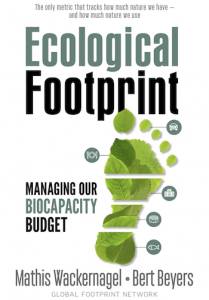
Contemplate this! What is our moral responsibility regarding climate change? I must admit I am embarrassed by my own superficial acceptance of that responsibility.
There are many things I could do better. For example, I could:
- walk or ride my bike instead of driving my car for short distances
- dress more appropriately for the existing temperature rather than adjusting the thermostat up or down
- consciously and actively spend my food dollars with companies that practice sustainable agriculture
- look for alternatives to fossil fuels for energy needs and in manufactured goods
- avoid single-use products and containers
- cast my vote for politicians who acknowledge the science of climate change and who will push hard for policy solutions
And that’s just the tip of the iceberg. We need to act because people are using natural resources faster than nature can renew itself. That refers to our ecological footprints.
What is your ecological footprint?

Around 2005, I read articles on how many planet earths would be required to support us if everyone consumed like an American (or a Swede, or a German, or a citizen of any country). The statistic for the United States at the time was 4.1 planets. By 2017, according to the Global Footprint Network, the number was 5.0 planets.
The Global Footprint Network, a partnership of organizations that share the vision of living within the means of the planet, gathers research to shape sustainability policy. Their website provides an online quiz for you to test the impact of your individual ecological footprint. Take the test to see for yourself the impact of your resource demands.
Climate Change Will Most Heavily Impact Our Youth
I was impressed by 16-year-old Greta Thunberg, who sailed to the United States from Sweden to urge immediate action on climate change. Her ability to speak so clearly in English (which is not her native language) at the UN Climate Change Conference was authentic and forceful.
While Greta has captured our attention, she is not the only young person demonstrating concern about the viability of planet earth.
Catherine, a 22-year-old German with a bachelor’s degree in business, posts a blog on sustainability practices.
Jonah Green, a 25-year-old internet film-maker, writer and comedian, hosts a YouTube channel. One of his recent episodes is a (somewhat cheesy) video on how many earths we need to live the way we do.
Millions of people, many too young to vote, protested globally last Friday (September 20) to battle climate change. Berlin, Melbourne, New York City, London, and many other locations were the sites of mass demonstrations. Anxious about their future, children and young people took to the streets. But it’s no secret their views are not universally shared.
Challenges and Hope
The New York Times has pointed out that climate protestors and world leaders, although inhabiting the same planet, live in different worlds.
“This is the world we live in: Punishing heat waves, catastrophic floods, huge fires and climate conditions so uncertain that children took to the streets en masse in global protests to demand action.
But this is also the world we live in: A pantheon of world leaders who have deep ties to the industries that are the biggest sources of planet-warming emissions, are hostile to protests, or use climate science denial to score political points.”
On the other hand, in an op-ed on the topic, there are signs of hope. Here are a few select statements.
- Today … solar and wind provide the cheapest sources of new electricity in two-thirds of the world
- The fastest-growing occupation in the United States is solar installer … The second-fastest growing job: wind turbine service technician.
- The number of electric vehicles on the road has increased by 450 percent in the past four years
- Evidence now indicates that we are in the early stages of a sustainability revolution that will achieve the magnitude of the Industrial Revolution and the speed of the digital revolution, made possible by new digital tools.
- A farmer-led regenerative agriculture revolution that is also underway avoids plowing and focuses on building soil health by sequestering carbon dioxide in the ground, making the land more fertile.
- The best available technology for pulling carbon dioxide from the air is something called a tree. That’s why many nations are starting ambitious tree planting efforts.
Even though these facts are encouraging, we have to do more. Complacency is NOT an option. We need policies and plans and implementation to succeed. We have a moral responsibility to be good environmental stewards for future generations. We can all contribute to making this world a better place.

What’s Your Next Step?
I’m aware that some people viewing this post don’t believe in the seriousness of climate change, and may therefore discontinue reading the blog. But I deem this important enough for me to risk it and take a solid stand.
Again, contemplate this. What can you do to be a better environmental steward?
